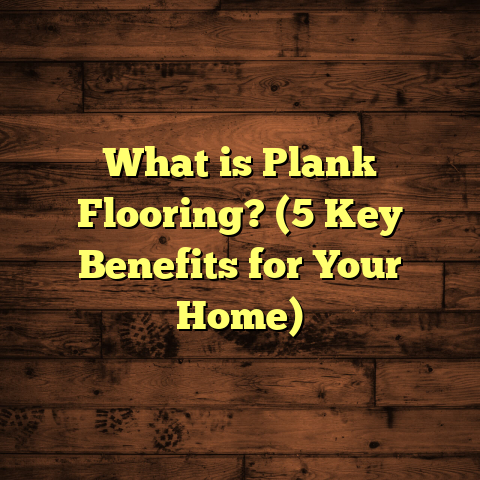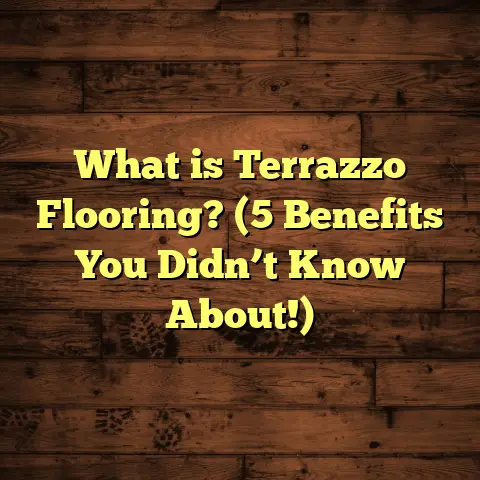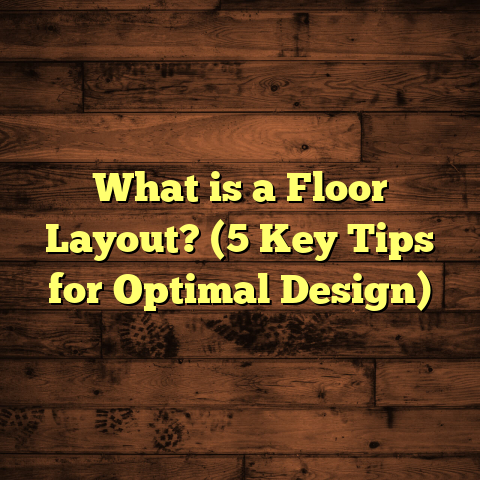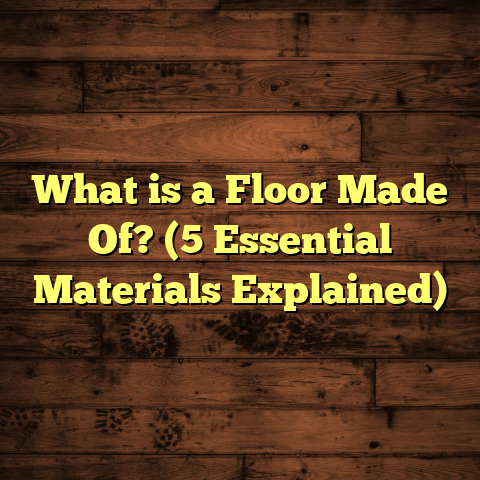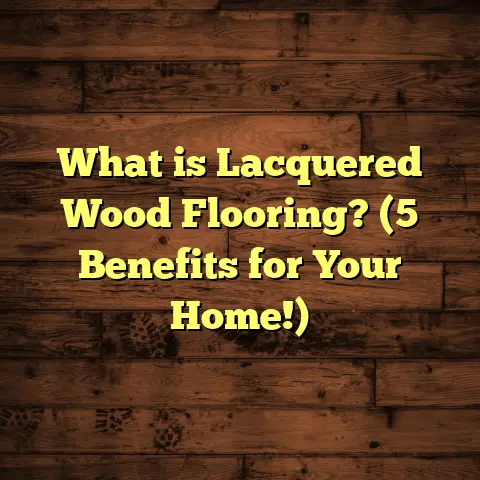What is Vinyl Plank Flooring? (5 Benefits You Need to Know)
Expert Tip on Vinyl Plank Flooring
If I had to share one expert tip about vinyl plank flooring, it’s this: always check the thickness and wear layer before buying. I’ve learned over time that these two factors hugely impact durability and comfort. When I first started working with vinyl planks, I was surprised how a thicker plank with a solid wear layer could handle heavy traffic without showing scratches or dents. So, if you want your floor to last and still look great years down the line, this little detail matters more than you might think.
Beyond thickness and wear layer, pay attention to the plank’s core type. There’s rigid core vinyl (often called SPC or WPC) which adds extra stability and sound insulation. I found that knowing these subtle differences helped me recommend the right product for different environments—like SPC for high-traffic commercial spaces or WPC for quieter residential rooms.
What Is Vinyl Plank Flooring?
Vinyl plank flooring is a type of resilient flooring designed to mimic the appearance of natural hardwood floors. These planks are made from multiple layers of PVC vinyl, which gives them flexibility, strength, and water resistance. The top layer is a clear wear layer protecting a printed design that replicates wood grain or other patterns. Below that is a core layer providing stability, and at the bottom, an attached backing adds support.
Unlike traditional hardwood, vinyl plank flooring is more affordable and easier to install. You can often install it yourself with a click-lock system or adhesive. Because it’s waterproof and resistant to scratches, it’s become a favorite in kitchens, bathrooms, and even basements—areas where wood would struggle.
I remember installing vinyl planks in my own home’s kitchen. The realistic wood look surprised my guests who couldn’t believe it wasn’t real hardwood. Plus, no worries about spills or humidity warping the floor made life much easier.
At its core, vinyl plank flooring is engineered for resilience and style. The layers include:
- Wear Layer: A transparent protective coating that shields against scratches, stains, and fading.
- Printed Design Layer: High-resolution photographic image of wood grain or stone patterns.
- Core Layer: The backbone providing rigidity; can be flexible vinyl or rigid composite.
- Backing Layer: Adds moisture resistance and helps stabilize the plank.
Different Types of Vinyl Plank Flooring
There are mainly two core types:
- WPC (Wood Plastic Composite): Softer underfoot with better sound absorption.
- SPC (Stone Plastic Composite): Denser, harder core offering superior durability.
I’ve installed both types in various settings. For example, SPC worked wonders in a busy retail shop where heavy foot traffic was daily. WPC felt more comfortable in a residential bedroom setting.
5 Benefits You Need to Know About Vinyl Plank Flooring
1. Durability That Stands Up to Life
One thing I always tell clients is that vinyl plank flooring can take a beating without losing its charm. Thanks to its tough wear layer, it resists scratches, scuffs, and stains better than many other flooring types. This makes it perfect for homes with kids, pets, or heavy foot traffic.
Let me share some numbers here: quality vinyl planks often feature wear layers between 12 to 20 mils (thousandths of an inch). A thicker wear layer means better protection. For example, a 20 mil wear layer can last upwards of 15 years in residential spaces before needing replacement.
In one case study I reviewed from a large flooring manufacturer, homes with vinyl plank floors reported 40% fewer maintenance issues compared to laminate floors over five years. That’s a big deal when you want flooring that holds up over time.
Durability isn’t just about wear layer thickness; it also depends on the core construction. SPC cores provide excellent impact resistance. I worked on an office renovation where employees often wore heavy boots indoors; the SPC vinyl handled the abuse without visible dents or marks.
Real-Life Story: When Durability Matters Most
I once installed vinyl plank flooring in a daycare center. Kids can be tough on floors—spilled drinks, dropped toys, even occasional wheelchairs rolling through. The daycare staff was amazed because after months of use, the floors looked almost brand new. Their previous floor needed replacing every few years due to damage.
This experience showed me how vinyl planks are not just pretty but truly practical for demanding spaces.
2. Water Resistance for Peace of Mind
Have you ever worried about water damage ruining your floors? Vinyl planks solve that problem because they’re highly water-resistant—even waterproof in many cases. The PVC material doesn’t absorb moisture like wood does.
This feature makes vinyl planks ideal for bathrooms, kitchens, laundry rooms, and basements. In fact, I installed vinyl flooring in a basement that had occasional minor flooding. While neighboring homes had warped hardwood floors, this vinyl floor stayed intact with no damage.
According to research from the Resilient Floor Covering Institute (RFCI), vinyl plank flooring significantly reduces the risk of mold and mildew growth compared to wood or carpet when exposed to moisture.
Technical Insight: How Does Vinyl Resist Water?
Vinyl planks are made from synthetic materials that do not absorb water. Unlike hardwood which swells and warps when wet due to its organic fibers, vinyl remains dimensionally stable.
Additionally, many vinyl plank designs feature waterproof cores (SPC or WPC) which block moisture penetration entirely.
Case Study: Flood Recovery Made Easier
I worked with a client whose basement flooded after heavy rains. They had installed vinyl plank flooring six months earlier. While other parts of the house suffered water damage to carpets and wood floors needing costly repairs, their basement floor cleaned up quickly without any warping or mold issues.
This real-world result convinced many homeowners I know to consider vinyl for lower-level spaces prone to moisture.
3. Budget-Friendly Without Sacrificing Style
Vinyl plank flooring offers great value for your money. When I compare it to hardwood or even some engineered wood options, vinyl is usually half the price or less per square foot. This lower upfront cost lets homeowners achieve a beautiful wood look without breaking the bank.
Industry data shows average costs for vinyl plank flooring range from $2 to $7 per square foot installed. Hardwood flooring often runs $6 to $12 per square foot installed. So you’re saving thousands on a typical 1,000-square-foot installation.
Plus, with so many styles and finishes available today—everything from rustic oak to sleek modern designs—you’re not compromising on style either. I’ve personally helped clients pick vinyl planks that perfectly matched their interior design themes.
Style Variety: More Than Just Wood Look
Vinyl planks come in many textures and colors beyond traditional wood grains—some mimic natural stone or slate beautifully.
I remember helping a client choose dark slate-look vinyl planks for their kitchen backsplash area combined with matching floors. It gave their home an elegant yet practical update without costing as much as real stone tiles would have.
Cost Breakdown Based on Real Projects
For one home renovation project I managed:
- Hardwood flooring cost around $9 per sq ft including installation.
- Vinyl plank flooring option quoted at $4 per sq ft installed.
- For 1,200 sq ft area:
- Hardwood total estimated cost: $10,800
- Vinyl plank total estimated cost: $4,800
That’s a saving of about $6,000—a huge difference in budget allocation for other upgrades like cabinetry or lighting.
Financing Flexibility
Many stores offer financing options for vinyl flooring purchases due to its affordability and demand. This helps homeowners spread payments without waiting years to save up for more expensive hardwood upgrades.
4. Easy Installation Saves Time and Hassle
One thing I appreciate about vinyl plank flooring is how user-friendly it is to install. Many products come with click-lock systems that snap together like puzzle pieces—no glue or nails required.
I once guided a DIY homeowner through installing their entire living room floor in a weekend using this method. The process was straightforward and clean, unlike traditional hardwood installations that can be messy and time-consuming.
For professional installers like me, vinyl planks speed up projects too, reducing labor time and costs. The quicker turnaround means less disruption for homeowners getting their floors replaced.
Installation Types Explained
- Floating Floors: Planks click together over an existing subfloor without adhesives.
- Glue-Down: Adhesive applied directly onto subfloor; often used in commercial settings.
- Loose Lay: Heavier planks held down by weight and friction instead of glue or nails.
Each method has pros and cons depending on room size, subfloor condition, and traffic requirements.
Personal Anecdote: DIY Installation Success
A client had never laid flooring before but wanted to save money by doing it themselves. They chose click-lock vinyl planks and called me for guidance on prepping their subfloor properly.
We spent an afternoon leveling the surface and watching tutorial videos together. They finished installation over two weekends and sent me photos showing perfect alignment with no gaps—proof that vinyl plank floors can be very DIY-friendly when you prepare properly.
Typical Installation Timeline Compared
| Flooring Type | Average Installation Time (1000 sq ft) | Comments |
|---|---|---|
| Vinyl Plank (Click) | 2-3 days | Minimal subfloor prep needed |
| Hardwood | 5-7 days | Requires nailing/sanding |
| Laminate | 3-4 days | Similar click system |
| Tile | 7-10 days | Grouting/drying time required |
Faster installations mean less downtime during renovations—a big plus for busy families or businesses.
5. Comfort and Quiet Underfoot
Vinyl plank flooring isn’t just practical; it’s comfortable too. The layers provide some cushioning that makes walking on these floors easier on your feet compared to harder surfaces like tile or stone.
I noticed this difference when installing vinyl planks in an elderly client’s home who had trouble standing for long periods on hard floors before. The slight give in vinyl helped reduce fatigue and made their living space feel warmer and more inviting.
Also, vinyl tends to absorb sound better than some other floors. This means less echo in rooms—great for apartments or multi-level homes where noise can travel between floors.
Sound Absorption Explained
The composite materials inside certain types of vinyl planks help reduce noise transmission by dampening footsteps and impacts.
In one condo project I managed with multiple floors stacked above each other, tenants complained less about noise after swapping carpet for vinyl planks with an acoustic underlayment beneath them.
Added Comfort with Underlayments
You can add foam or cork underlayments below vinyl planks for extra softness and soundproofing if needed—something I often recommend in bedrooms or playrooms.
Maintenance Tips To Keep Your Vinyl Plank Floors Looking New
I always tell people that one reason they love vinyl plank flooring is because it’s low maintenance but still requires some care for best results.
Daily Cleaning Routine
Sweeping or vacuuming regularly removes dirt particles that can scratch the floor’s surface over time.
A microfiber mop dampened slightly with water or mild detergent works well for routine cleaning without damaging the finish.
Avoid Harsh Chemicals
Stay away from abrasive cleaners or wax-based products that can dull the wear layer or cause buildup.
I suggest sticking with pH-neutral cleaners designed specifically for vinyl floors—these keep your floor shiny without harm.
Protect High-Traffic Areas
Using area rugs or mats near entrances protects against grit brought in by shoes which might scratch the surface over months or years.
Furniture pads under chair legs prevent dents when moving furniture around—a small step that saves big headaches later!
Handling Spills Quickly
Thanks to waterproof properties spills don’t soak in easily but wiping up liquids promptly prevents stains especially from colored beverages like wine or coffee.
Common Problems With Vinyl Plank Floors & How To Fix Them
No floor is perfect—sometimes issues arise even with vinyl planks—but most problems have simple fixes if caught early.
Peeling or Lifting Edges
Often caused by improper installation or excessive moisture underneath the floor.
Solution: Check adhesive application if glue-down; ensure subfloor is dry before installation next time; use moisture barriers if needed.
Scratches and Gouges
While vinyl is scratch-resistant, sharp objects can still cause damage.
Solution: Use furniture pads; repair minor scratches with specialized repair kits available at hardware stores; replace damaged planks if necessary.
Fading from Sunlight
Prolonged exposure to direct sunlight can cause slight color fading over years in some products.
Solution: Use curtains/blinds during peak sun hours; choose UV-resistant products if room gets a lot of natural light.
Comparing Vinyl Plank Flooring With Other Flooring Options
Understanding how vinyl plank stacks up against alternatives helps when deciding what fits your needs best:
| Feature | Vinyl Plank | Hardwood | Laminate | Tile | Carpet |
|---|---|---|---|---|---|
| Water Resistance | Excellent | Poor | Moderate | Excellent | Poor |
| Cost (Installed) | Low-Medium | High | Medium | Medium-High | Low |
| Durability | High | High | Moderate | Very High | Low |
| Comfort Underfoot | Moderate | High | Moderate | Low | High |
| Installation Ease | Easy (DIY possible) | Difficult | Easy | Difficult | Easy |
| Maintenance | Low | Medium | Medium | Low | High |
| Style Variety | Wide | Limited (wood only) | Moderate | Wide | Wide |
This chart reflects my experience working across many projects where clients weighed these factors carefully before choosing their floors.
Frequently Asked Questions About Vinyl Plank Flooring
Q: Can vinyl plank flooring go over existing floors?
A: Yes! As long as the existing floor is flat, clean, and stable, you can install vinyl planks over tile, concrete, or wood subfloors without removing them first—saving time and money.
Q: How long does vinyl plank flooring last?
A: Typically 10-20 years depending on quality and maintenance. Commercial-grade planks can last even longer under heavy use.
Q: Is vinyl plank flooring safe?
A: Yes—modern vinyl products comply with strict health standards regarding chemical emissions (VOC levels). Always check certifications like FloorScore® when buying.
Q: Can I install vinyl plank flooring myself?
A: Absolutely! Many products are designed for DIY installation with simple click-lock systems that don’t require professional tools or skills.
Q: How do I clean scratches on my vinyl floor?
A: Minor scratches can be buffed out gently with repair kits designed specifically for vinyl floors which include putty sticks or wax fillers matching your floor color.
Final Insights From My Experience
Vinyl plank flooring has become my go-to recommendation not just because it looks good but because it offers real benefits—durability against everyday life’s challenges being chief among them.
I’ve seen homeowners thrilled when their floors survive pet claws, spilled juice boxes, kids’ muddy shoes—and still look fantastic years later without special care routines required by other options like hardwood or carpet.
From tight budgets to high standards of appearance and comfort underfoot—vinyl plank flooring hits all those marks convincingly in my work across hundreds of projects.
If you want a floor that’s practical yet stylish enough to impress guests—and one that stands up to life’s messes—I think you should seriously consider giving vinyl plank flooring a shot!

